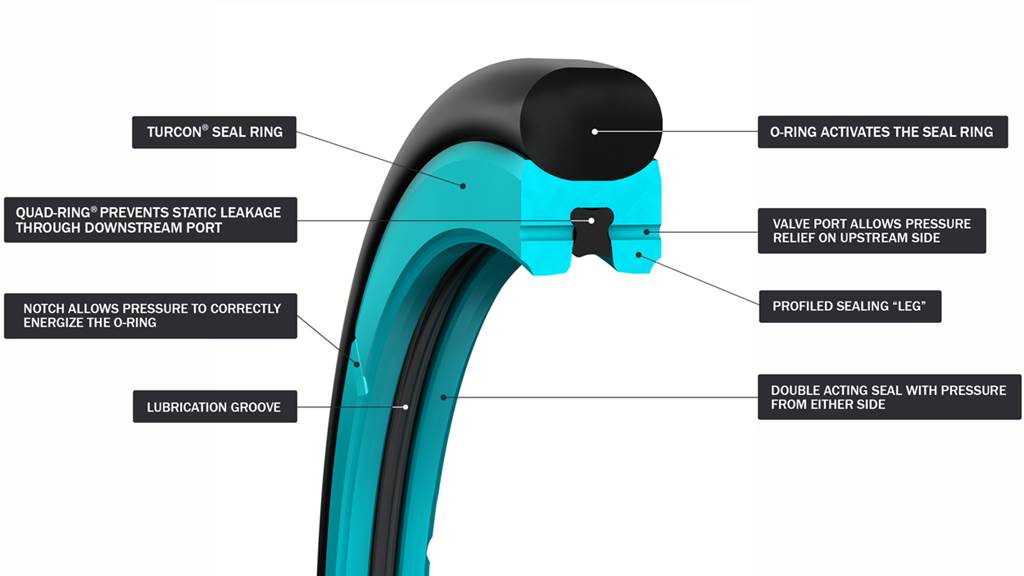
Trelleborg Sealing Solutions launches an innovative seal, Turcon® Roto Glyd Ring® V, which is primarily intended for double-acting pressure within severe working conditions that require extended rotary service. The seal is specifically engineered for machinery where a high pressure to velocity value is required to allow equipment to run at the highest possible speeds in high pressures for an extended service life.
Turcon® Roto Glyd Ring® V is a premium double-acting rotary seal with outstanding performance and reliability. Reduced contact surfaces under all operating conditions significantly improve friction and wear characteristics without compromising sealing performance. Designed for continuous service at high and low PV values, the seal also gives improved performance in oscillating conditions or where there are frequent changes in pressure and/or velocity.
Higher speeds and pressures
Henrik Vollmond, Product Manager, says: “Customers are demanding increased performance from rotary seals that challenge the PV values of current seals. We therefore needed to develop a rotary seal that can run at higher speeds combined with higher pressures. This resulted in the development of the unique Turcon® Roto Glyd Ring® V, which not only achieves these requirements but also, by virtue of lower heat generation, offers a significantly extended seal life. For the equipment operator that means lower overall costs due to reduced maintenance requirements and energy consumption.”
Test results show that Turcon® Roto Glyd Ring® V runs with low frictional torque at all pressures from 0.5 MPa and above with low sensitivity to pressure increases from 0.5 to 20 MPa. It achieved a PV twice as high as other bidirectional seals and demonstrated 50% lower friction. Furthermore, wear of the seal and O-Ring was so low that it could not be measured.
Built-in features
Like other O-Ring activated Slipper Seals, the initial squeeze of the O-Ring ensures sufficient contact pressure between seal and mating surface to provide tightness at low pressure. With increasing system pressure, the O-Ring and the seal body direct have a contact force on the sealing surface to ensure sealing efficiency at all pressures.
Turcon® Roto Glyd Ring® V has a built in valve function. Valve ports are made from both sides of the Turcon® ring profile to the space in the center, which is the lubricating groove. An elastomer ring is installed in the lubricating groove to prevent static leakage through the ports.
When Turcon® Roto Glyd Ring® V is pressurized from one or the other side, the elastomer ring opens the port on the pressure side and equalizes the pressure beneath the elastomer ring – pressure balancing the seal by more than half. Shifting pressurization through the ports also renews the fluid in the space between the “legs”, improving lubrication under the seal.
Long service life in demanding conditions
Turcon® Roto Glyd Ring® V is ideal for equipment for which a long service life is required in demanding service conditions. Typical examples are machining centers, hydraulic swivels, lead-troughs, rotary connections with swivel movements, excavators, forestry machinery, hydraulic rotators, robots, manipulators, indexing tables, pivoting motors, hydraulic motors, blow molding machines, top drives and core cutting equipment.
With maximum recommended operating temperatures of +100 °C/ +212 °F (up to +150°C/ +302°F at lower PV-values), Turcon® Roto Glyd Ring® V is designed to fit into standard Roto Glyd Ring® grooves. It is available in four cross section series; for shafts in diameters from 35 to 500 millimeters/ 1.377 to 19.685 inches and for bores from 22 to 500 millimeters / 0.866 to 19.685 inches.
When specifying Turcon® Roto Glyd Ring® V, users should note the following. Pressure should be limited to a maximum of 30 MPa. Velocity needs to be limited to 2.0 meters per second. The Roto Glyd Ring® V has been successfully tested up to a combined PV of 10 MPa.m/s.
A patent application has been submitted.

 Industry News
Industry News